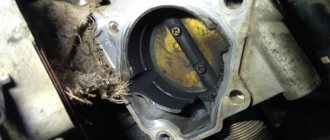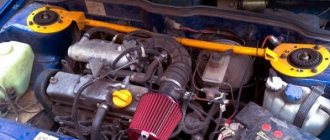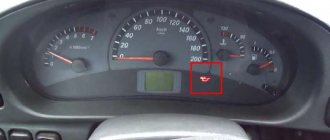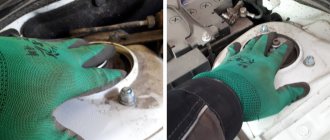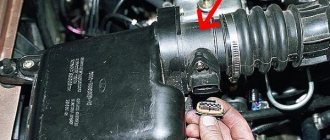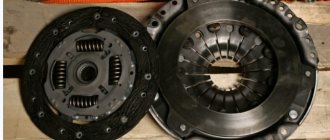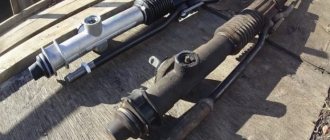Lada Vesta is equipped with one of two gasoline engines – 21129 (1.6 l.) or 21127 (1.8 l.). The control system is electronic. Initially, the operation of the computer and feedback sensors is finely tuned. However, over time, a problem arises - instability of speed at idle and while driving. Determining the exact cause is often difficult due to the fact that the Check Engine light does not light up, so scanning the ECU is useless. Still, you can identify the flaw of uncomfortable functioning on your own.
Power point
The main complaints from consumers concern the domestic 1.6-liter engine with 106 horsepower.
The most common problems: the engine “troubles”, and at idle the speed “floats”. All this is accompanied by irritating vibrations, a decrease in unit power (one cylinder does not work) and an increase in fuel consumption. Dealers consider this problem individually, since it depends on many factors, including the most common one - fuel quality. For example, our test car (with a 106-horsepower engine and five-speed manual transmission) did not have such a problem. But the second “sore” showed itself: the engine does not start immediately, but after several seconds of starter operation. Simply put, not with half a turn, as any engine should start. Plus, after they began installing the Russian VAZ-21807 gearbox on the Vesta (previously it had a Renault transmission), complaints arose about unclear gear shifting and whining. AvtoVAZ corrected the gear shift mechanism itself, but the annoying transmission noise remained.
It is noticeable that VAZ specialists, working on the new Lada Vesta sedan, set out to ensure maximum reliability and trouble-free operation of the model. That is why the line of power units includes engines familiar from other Alliance cars. Of course, they have weaknesses, but all “childhood diseases” have long been defeated and by modern standards these motors are considered very reliable.
Lada Vesta - many people are waiting for this sedan to enter the market.
About sound insulation of Lada Vesta SW
According to AVTOVAZ representatives, the new LADA has sharply increased its level of sound comfort. For several years, foreign cars have had one noticeable advantage - acoustic comfort. Today the interior of the Lada Vesta SW is quieter than that of its competitors. Is it so?
The interior of the Lada Vesta SW Cross was disassembled and found out:
- There are vibration-absorbing materials, but only partially. For example, they are on the left rear arch, but not on the right.
- There is sound insulation in the form of felt in the cabin and trunk.
- Microfiber is used in the doors.
- The technological openings in the doors are closed.
- The entire floor surface is soundproofed in the form of felt. But in the front part it has a moisture-proof coating on top, but not in the back.
Let us remind you that the easiest and fastest way to improve sound insulation is to cover the fender liners and wheel arches. Also read how to get rid of squeaks in Vesta’s interior.
Keywords: sound insulation of Lada Vesta | Lada Vesta engine
3
Found an error? Select it and press Ctrl+Enter..
Problems with the VAZ 21116 engine
This is a modified power unit of the VAZ 21114 type. The improvements resulted in the installation of a 39% lighter ShPG from the Federal Mogul company. The good thing about the engine is that if the timing belt breaks, the valves do not bend. However, if signs of a malfunction are detected, it is better not to delay and immediately go to the service station.
VAZ 21116 is the most affordable engine under the hood of Vesta.
Engine design features
The operation of this power unit has a number of distinctive features:
— the need for periodic valve adjustment;
Valve adjustment is required for this engine.
— frequent replacement of the oil filter;
— rapid wear of cooling system components;
— oil leakage through a poor-quality valve cover seal;
Oil leakage is another possible problem.
- frequent breakage of brackets on the exhaust exhaust pipe - steel nuts are used instead of brass.
Typical faults
Troubling and uneven operation - to detect the cause, it is necessary to measure the compression in the cylinders. If in one of them it is noticeably different, this means that the valve has burned out. If there is a slight difference in the indicators, the source of the problem is in the gasket or you simply need to adjust the valves. If everything is normal with compression, the cause should be looked for in the ignition module.
Changes in compression are one of the reasons for uneven operation.
Floating speed - usually a similar problem occurs on new cars. To fix it, you should go to a service center, where it will be repaired under warranty. Otherwise, you need to inspect the vacuum seal, throttle position sensor and idle air control.
Due to the throttle position sensor, the engine speed may fluctuate.
The engine does not heat up to the required temperature level - the problem is in the thermostat. In addition, even new components often fail. Consequently, the breakdown may recur soon after replacement.
The thermostat is one of the components that often requires replacement.
Noises and knocking in the engine are usually due to valves that need to be adjusted. If you hear a muffled metallic hum that increases when you press the accelerator pedal, then the connecting rod bearings or crankshaft bearings are knocking. This problem can only be solved in the service. The knocking of pistons in the cylinders is also possible. This is also a reason to visit the dealer at the service station.
What materials are used to reduce noise
To carry out the work yourself, you will need an impressive list of materials. Moreover, the complete set varies according to the purpose - to ensure complete sound insulation of Vesta or only for doors.
Shvi set for doors:
| Material | Specifications | Number of pieces/sheets |
| Super light vibrosheet 0.2 cm thick | 0.5x0.6 m | 10 |
| Sealing anti-creaking polyurethane material with wavy relief and adhesive layer | 0.75x1 m | 4 |
| Anti-creaking material glued tape | 2.5 cm | 5 linear meters |
| Anti-creaking class Velor, glued | 0.2x1.4 m | 1 |
| Degreasing agent Khimik | 0.5 liters | 1 |
| Caprolon roller | D 3.2 cm, width 4 cm | 1 |
| Sheet cutter | At 18 mm | 1 |
| Cotton gloves | with PVC coating | 1 |
For a full ShVI you will additionally need:
- Vibrating sheet with a thickness of 2 and 3 mm, dimensions 0.5x0.76 m - 20 and 6 sheets, respectively.
- Glued sheet material with a thickness of 6 and 10 mm, size 0.75x1 m - 6 and 2 sheets, respectively.
- Glued isolon P8 0.56 x 0.75 m - 5 sheets.
- Dismantling tool.
Strictly speaking, depending on the goals of the car owner, the set of materials both on the door and for the entire car can be complete or minimal. If the driver drives alone, minimal modifications are sufficient. If the machine is used as a service vehicle, it makes sense to equip it to the maximum.
Problems with the VAZ 21127 engine
The VAZ 21127 engine is a slightly modified and modified VAZ 21126 power unit. The differences lie in the installed intake system, equipped with a resonance chamber with the ability to adjust its volume due to controlled dampers.
The VAZ 21127 engine is a modernized VAZ 21126.
Instead of the mass flow sensor, the designers installed DBP+DTV, which eliminated the problem with floating speed. Like its predecessor, this engine also bends the valve when the timing belt breaks.
Peculiarities
Owners of Lada Vesta need to take into account possible problems and also know options for solving them:
- Unstable operation and inability to start can be caused by irregularities in the timing belt, problems with fuel pressure, air leaks, breakdown of the throttle valve, as well as malfunction of some sensors.
- Loss of power - the cause is a burnt-out gasket, as a result of which compression in the cylinders decreases, as well as wear of components (burnout of pistons, wear of rings and cylinders). However, the owners of the new Vesta do not face such problems (at least at first).
- Valve bending - this problem can be solved by replacing the standard pistons with those of the plug-in type.
Bent valves are one of the most serious failures of this Vesta engine.
Typical faults
They are similar to those that characterize the VAZ 21126 engine.
The Vesta VAZ 21127 engine may start to stall. In this case, it will not be superfluous to flush the injectors. If this procedure does not help, you should pay attention to the ignition coils, spark plugs and measure the compression. However, it is best to go straight to the service station.
When the Vesta power unit triples, washing the injectors can help.
There may also be a problem warming up to operating temperature. This usually occurs when the thermostat is faulty.
Noises and knocks in the engine can occur due to hydraulic compensators, as well as problems with the main and connecting rod bearings or pistons. If vibration occurs in the Vesta engine, it is worth inspecting the injectors and high-voltage wires.
What the reviews say
Lada Vesta has been in the hands of many journalists who tried to find its advantages and disadvantages. If we talk specifically about sound insulation, one of the first opinions on this matter was expressed by Anton Avtoman in his video review. Even before starting to drive, “playing” with idle speed, he noted the noisy engine and the need to install additional noise.
Autoreview experts checked the sedan more globally. To get an assessment of Vesta's noise insulation, they compared it with competitors: Ford Fiesta, Kia Rio, Renault Logan, Volkswagen Polo. According to test results:
- The Kia Rio and Ford Fiesta received the highest score.
- Volkswagen Polo and Lada Vesta have average noise levels. In terms of acoustic and vibration comfort, both sedans are approximately on the same level, but Vesta’s engine turned out to be a little quieter than that of the German.
- Renault Logan ended up in last position.
Sound insulation measurements by ZaRul magazine.
Up to 110 km/h, the cabin is quieter than in the Ford Fiesta. After installing fender liners with shvi, the noise level becomes at the level of a Skoda Octavia or Ford Focus.
Noise inside the Lada Vesta SW and Lada Vesta SW Cross at a speed of 120 km/h (determined during life tests):
| FORD FOCUS | HYUNDAI CRETA | LADA VESTA SW CROSS | LADA VESTA SW | |
| With box on the roof | 74,4 | 73,95 | 75,7 | 75,6 |
| Without boxing | 69,9 | 69,4 | 71,3 | 71,7 |
| Difference | 4,5 (6,4%) | 4,55 (6,5%) | 4,4 (6,1%) | 3,9 (5,4%) |
Another measurements from ZaRulem magazine (Vesta with CVT):
| Hyundai Solaris | Lada Vesta | Volkswagen Polo | |
| 60 km/h | 64 | 67 | 62 |
| 80 km/h | 67 | 70 | 65 |
| 100 km/h | 71 | 71 | 67 |
| Tires | Kumho EcoWing ES01 | Matador Elite3 | Continental Premium Contact 5 |
Renault-Nissan HR16DE-H4M
The production of this power unit began in 2006. In general, the engine, which still remains the most powerful in the Vesta line (the output of the 1.8-liter unit is questionable), is considered very reliable and is capable of driving about 250,000 km to the capital.
The Renault-Nissan HR16DE-H4M engine is the most powerful in the Vesta line.
Focused on AI-95, but easily “digests” the 92nd. In addition, its timing system uses a chain that is reliable, so Vesta owners should not worry about its stretching too early.
The timing chain in the Renault-Nissan HR16DE-H4M engine is more reliable than the belt.
Sound insulation of Lada Vesta doors
Here it is also necessary to act extremely carefully - when removing the casing, we try not to damage its components. We use a special solution to degrease surfaces.
Doors are a very problematic area - so we initially glue Dark D3 inside the door. To dampen the frame, we also use Comfort mat Dark D3, sealing all technological holes - now the car will not only become quiet, but will also significantly improve the sound quality of the standard acoustics. We finish everything with a layer of Comfort mat Wave 15 mm, which reliably protects against sound waves from the street and squeaks from the sheathing.
What the reviews say
Lada Vesta has been in the hands of many journalists who tried to find its advantages and disadvantages. If we talk specifically about sound insulation, one of the first opinions on this matter was expressed by Anton Avtoman in his video review. Even before starting to drive, “playing” with idle speed, he noted the noisy engine and the need to install additional noise.
Autoreview experts checked the sedan more globally. To get an assessment of Vesta's noise insulation, they compared it with competitors: Ford Fiesta, Kia Rio, Renault Logan, Volkswagen Polo. According to test results:
- The Kia Rio and Ford Fiesta received the highest score.
- Volkswagen Polo and Lada Vesta have average noise levels. In terms of acoustic and vibration comfort, both sedans are approximately on the same level, but Vesta’s engine turned out to be a little quieter than that of the German.
- Renault Logan ended up in last position.
Sound insulation measurements by ZaRul magazine.
Up to 110 km/h, the cabin is quieter than in the Ford Fiesta. After installing fender liners with shvi, the noise level becomes at the level of a Skoda Octavia or Ford Focus.
Noise inside the Lada Vesta SW and Lada Vesta SW Cross at a speed of 120 km/h (determined during life tests):
| FORD FOCUS | HYUNDAI CRETA | LADA VESTA SW CROSS | LADA VESTA SW | |
| With box on the roof | 74,4 | 73,95 | 75,7 | 75,6 |
| Without boxing | 69,9 | 69,4 | 71,3 | 71,7 |
| Difference | 4,5 (6,4%) | 4,55 (6,5%) | 4,4 (6,1%) | 3,9 (5,4%) |
Another measurements from ZaRulem magazine (Vesta with CVT):
| Hyundai Solaris | Lada Vesta | Volkswagen Polo | |
| 60 km/h | 64 | 67 | 62 |
| 80 km/h | 67 | 70 | 65 |
| 100 km/h | 71 | 71 | 67 |
| Tires | Kumho EcoWing ES01 | Matador Elite3 | Continental Premium Contact 5 |
Is it worth it to soundproof Vesta yourself?
By independently enhancing the original sound insulation, Vesta owners will receive a number of advantages. First of all, get rid of the creaking of all plastic elements. Besides:
- the noise level will decrease under any operating mode;
- it will be possible to drive the car in complete silence and talk to passengers without straining your voice;
- when traveling long distances, fatigue will decrease;
- the sound of the speakers will improve;
- drafts will disappear even at high speeds, due to this the temperature in the cabin will become stable.
The body will also receive additional benefits, since it will be less susceptible to corrosion.
With high-quality insulation, the surfaces are first cleaned, then degreased, and the insulation is properly rolled and a reliable adhesion is achieved that prevents the penetration of air and moisture.
However, self-made shvi also has its disadvantages. Interior elements may be damaged during dismantling and reinstallation. If there is an error with the thickness of the material, some parts will be installed offset. There will be places for condensation to accumulate. Due to moisture, corrosion will quickly begin to develop.
Soundproofing Vesta's interior
High-quality insulation can only be done with experience. It is recommended that the first layer of ShMI—vibration isolation—be ordered from a service center, where the material will be rolled tightly without bubbles or unevenness. It is easier to install the next 2 layers yourself: the soundproofing material is covered with glue. It is enough to clean and degrease the surface, remove the protective layer and press the sheet.
Operating principle of the electronic pedal
E-gas is no longer a new thing. If previously the throttle valve was opened using a cable, today the gas pedal device is literally “tied” to sensors. The pedal module itself is completely covered with plastic, behind which (in the bracket) two sensors with a spring are installed. When the driver presses the lever, the spring is compressed, and sensors (potentiometers) read this position.
Its position is read by two sensors, transmitting the received information to the ECU - “reporting” on the work done. It would seem that the system has become much more complex and incomprehensible. It has become more environmentally friendly, since the ECU has an over-throttle lock - even if you hit the pedal, pressing it to the floor, the damper will not open “to its full amplitude”.
Light engine vibration at idle on Vesta: diagnosis of causes
Lada Vesta is equipped with one of two gasoline engines – 21129 (1.6 l.) or 21127 (1.8 l.). The control system is electronic. Initially, the operation of the computer and feedback sensors is finely tuned. However, over time, a problem arises - instability of speed at idle and while driving. Determining the exact cause is often difficult due to the fact that the Check Engine light does not light up, so scanning the ECU is useless. Still, you can identify the flaw of uncomfortable functioning on your own.
Vesta 1.6 runs cold + check. Help.
Good day to all. Tell me where to dig. Vesta 1.6 When cold, at night when starting it shakes a lot and the check light comes on. Errors P0363, P1301 - misfire and cylinder shutdown. I changed and rearranged the coils, changed and rearranged the spark plugs. When hot it works smoothly, there are no gaps in diagnostics. Only in cold weather such nonsense. Gasoline 95 from different gas stations.
What the hell is this bucket missing? Mileage 35t.r.
Thanks in advance for your answers.
If you turn it off right away and start it, the check goes out, the tripping seems to disappear. or a little less.
Crap. The wires need to be changed, that's for sure. But how can a valve or injector affect misfire when it’s cold? If the valve were burnt out, it would probably always leak? Nozzle. Is it being cleaned or replaced?
The injectors are washed. Or they change it. In your case, you can do the same as with the coil - swap the injectors. If the problem is in the injector, the error should go to another cylinder
The valve may be stuck due to carbon deposits, the injector may have worn out inside due to age, or become clogged with bad gasoline. but your mileage is only 35 - that’s just nothing. I'd check the electrical first.
What exactly should I check? Wires? There seems to be nothing special to check there.
Just logically. If it was an injector, then it would probably always fire, but when it’s hot, everything is smooth, there are no gaps. If the valve? The intake one sticks and floods the spark plugs, again, then it would always be leaking, etc.? Hydraulics, maybe the oil is drained, and when starting the valves are open and gasoline pours onto the spark plug and an error occurs? (change the oil? which one is better?) Or am I thinking wrong?
on this topic can be closed as another stuffing)))
I didn't understand. And why, when I created a topic about Vesta, about the fact that it doesn’t work, there was such a fuss! and dEbil. And Vasyan. Who entrusted this driver with the steering wheel? ALEN. News cannon race. You're lying.
And then I see they started to suggest something. Eh, TS, don’t take us for suckers here! Vesta cannon racing. ))))) You made it all up! No one will help you here. The way you lie.
What exactly should I check? Wires? There seems to be nothing special to check there.
Just logically. If it was an injector, then it would probably always fire, but when it’s hot, everything is smooth, there are no gaps. If the valve? The intake one sticks and floods the spark plugs, again, then it would always be leaking, etc.? Hydraulics, maybe the oil is drained, and when starting the valves are open and gasoline pours onto the spark plug and an error occurs? (change the oil? which one is better?) Or am I thinking wrong?
Wrong. Draining oil from the hydraulic valve does not open the valve. Yes, and it should click until it fills with oil.
I don’t really understand what your post is about, but it’s off topic.
Should I go to the car service center where I bought it? Is it under warranty?
In July the warranty expired, I bought it second hand. Of course, I simply didn’t see such a problem, because... I looked at the warmed up car.
Do not pay attention . These are strangers, aliens.
Good day to all. Tell me where to dig. Vesta 1.6 When cold, at night when starting it shakes a lot and the check light comes on. Errors P0363, P1301 - misfire and cylinder shutdown. I changed and rearranged the coils, changed and rearranged the spark plugs. When hot it works smoothly, there are no gaps in diagnostics. Only in cold weather such nonsense. Gasoline 95 from different gas stations.
What the hell is this bucket missing? Mileage 35t.r.
Thanks in advance for your answers.
If you turn it off right away and start it, the check goes out, the tripping seems to disappear. or a little less.
You have it under warranty. Let the officials sort it out, no?
And so they correctly wrote “stuffing” above.
Well then we can congratulate you. The car has not 35 thousand mileage)))
That's a normal mileage, I've seen ones with mileage under 100 tons, the difference is noticeable. NU and online services and insurance and dealer confirmed. There’s just a problem somewhere that needs to be fixed, but I don’t see any point in changing the motor right away
For thought: With the battery connected, I have a Colt Troil in the cold. Charged the battery - it went away.
If not spark plugs or IKZ, then air leaks.
Look for air leaks: Blow smoke into the intake with the engine turned off. Smoke generator: bottle/can + 1-2 nipples from a tubeless camera + coolant return hose + cigarettes + pump/compressor + hands. Or at least start and plug the inlet hose from the filter to the remote control with your palm and listen to where the suction is; if there is no suction, it will stall, if there is, it will pull. Or spray some water while running on “potential places” (the injector entrance to the block, the intake joint to the block, it is unlikely, but the remote control gasket to the intake). The brain can also do a PPA and drive air through it, so disconnect it from the inlet, plug the fitting at the inlet (piece of hose + bolt), although when the brain does it, usually when it’s hot at 20 rpm, the rpms fail, but it depends on the brain’s firmware.
If you find a leak in the intake, don’t even think about buying new BRT/Rosteco gaskets (black or white rubber) or going to the authorities, otherwise in 2 months you’ll suffer with the same thing! You order/buy gaskets for the PTP64 intake, blue or white (Google can help), rings for Bosch injectors and then change (either yourself or not, it’s up to you as you can).
Lada Vesta, elimination of car jerking.
Like most Vesta owners, I encountered the car jerking or pitching, as if you were releasing the clutch pedal incorrectly at the beginning of my “automotive career,” even though I had 10 years of driving experience, but at these moments I felt like an unrealistic teapot.
Over the course of a year, I tried to adapt and reduce these negative consequences when changing gears, but occasionally it slipped and became very annoying.
There were two options to solve this problem:
1. Flash the car.
2. Walk the “thorny path”, i.e. correct the machine's deficiencies yourself.
The first option was attractive, but for the time being, until thematic groups in social networks. Negative reviews about would-be stitchers and pleas for help did not appear on the networks.
Since the car is serviced by an official dealer, I didn’t want to void the warranty. If there was any serious malfunction of the internal combustion engine, the OD would find out that the car was “flashed” and would refuse warranty repairs.
So, I chose the second option for myself and acquired a new status - I’m an engineer with my mother)
Some methods are not materially expensive and can be done by anyone, provided that the hands grow from the right place. Some will hurt your pocket, I decided to use these methods because of a torn muffler corrugation, because... The internal combustion engine was dangling in the engine compartment like a genital in an ice hole.
I will briefly describe the solutions and at each point there will be a link to my articles, where each of the proposed methods is widely discussed.
The easiest and most accessible way for everyone, where you will need hours and 5 minutes of personal time. But this is a temporary solution; this method must be repeated periodically.
The second method, more significant, significantly reduced the negative consequences and created an almost instant response from the gas pedal.
The third method helps, but not significantly, some call it the placebo effect. Some people don’t feel the effect, but for me it was noticeable.
The fourth method also significantly reduces twitching, but due to another problem, the effect decreases over time; the solution will be written below.
The fifth method also gives a noticeable effect
Because oil was driven through the first crankcase exhaust circuit into the intake manifold, then the DBP sensor became clogged, which is why they returned to what it was.
The other two methods do not affect the internal processes of the internal combustion engine - this is replacing the engine mounts with alternative ones, the replacement gives a smaller amplitude of engine vibration, which also has a positive effect on the muffler corrugation and does not tear it.

